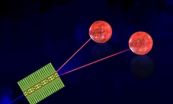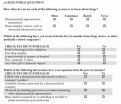(Press-News.org) STANFORD, Calif. — Researchers at the Stanford University School of Medicine have identified a group of progenitor cells in the inner ear that can become the sensory hair cells and adjacent supporting cells that enable hearing. Studying these progenitor cells could someday lead to discoveries that help millions of Americans suffering from hearing loss due to damaged or impaired sensory hair cells.
"It's well known that, in mammals, these specialized sensory cells don't regenerate after damage," said Alan Cheng, MD, assistant professor of otolaryngology. (In contrast, birds and fish are much better equipped: They can regain their sensory cells after trauma caused by noise or certain drugs.) "Identifying the progenitor cells, and the cues that trigger them to become sensory cells, will allow us to better understand not just how the inner ear develops, but also how to devise new ways to treat hearing loss and deafness."
The research will be published online Feb. 26 in Development. Cheng is the senior author. Former medical student Taha Jan, MD, and postdoctoral scholar Renjie Chai, PhD, share lead authorship of the study. Roel Nusse, PhD, a professor of developmental biology, is a co-senior author of the research.
The inner ear is a highly specialized structure for gathering and transmitting vibrations in the air. The auditory compartment, called the cochlea, is a snail-shaped cavity that houses specialized cells with hair-like projections that sense vibration, much like seaweed waving in the ocean current. These hair cells are responsible for both hearing and balance, and are surrounded by supporting cells that are also critical for hearing.
Twenty percent of all Americans, and up to 33 percent of those ages 65-74, suffer from hearing loss. Hearing aids and, in severe cases, cochlear implants can be helpful for many people, but neither address the underlying cause: the loss of hair cells in the inner ear. Cheng and his colleagues identified a class of cells called tympanic border cells that can give rise to hair cells and the cells that support them during a phase of cochlear maturation right after birth.
"Until now, these cells have had no clear function," said Cheng. "We used several techniques to define their behavior in cell culture dishes, as well as in mice. I hope these findings will lead to new areas of research to better understand how our ears develop and perhaps new ways to stimulate the regeneration of sensory cells in the cochlea."
Cheng recently received a grant from the California Institute for Regenerative Medicine to study the limited regeneration of the same sensory hair cells that occur in a different region of the inner ear called the vestibular system, which helps us balance. Lessons learned there may also translate into aid for patients with hearing loss.
Although regeneration of sensory hair cells does not happen naturally, recent research has suggested that the mammalian ear may harbor a sub-population of — presumably inactive — progenitor cells. The research team led by Cheng and Nusse used a strain of laboratory mice that allowed the scientists to track the activation of a cell-signaling pathway driven by a protein called Wnt. The Wnt pathway has previously been shown to be involved in many developmental functions, and it drives the renewal and proliferation of many types of stem cells.
"We wanted to investigate the Wnt pathway because of its tremendous influence in the development and regeneration of many other organs," said Cheng.
The researchers found that tympanic border cells, or TBCs, which form a thin layer under the sensory epithelium, are actively dividing in mice during the first three weeks after birth (the time corresponding to about the first trimester of human development, during which the ability to hear is established) and give rise to at least a subset of sensory and non-sensory cells in the ear. They also divided vigorously in isolated cochlea when the Wnt pathway was activated, and stopped when the pathway was inhibited. Finally, the researchers showed that purified TBCs were able to specialize into hair cells and support cells when cultured in a laboratory dish.
"It's surprising to think that these progenitor cells are among this largely underappreciated group of cells," said Cheng. "This study also highlights that, even in mice, there is a lot of maturation occurring after birth as hearing develops. There's clearly a lot more to be understood. Next we'd like to look at these cells in models of hearing loss. Do they have the ability to regenerate? If so, under what conditions?"
###
Other Stanford researchers involved in the study include medical students Zahra Sayyid and Jared Levin; former postdoctoral scholars Renée van Amerongen, PhD, and Saku Sinkkonen, MD, PhD; senior research scientist Anping Xia, MD, PhD; postdoctoral scholars Tian Wang, MD, and Yi Arial Zeng, PhD; and Stefan Heller, PhD, professor of otolaryngology.
The research was funded by the Howard Hughes Medical Institute, the European Molecular Biology Organization, the Dutch Cancer Society, the National Institutes of Health (grants DC010363, DC006167 and DC011043), the American Otological Society, the Triological Society, a Percy Memorial Award, the Akiko Yamazaki and Jerry Yang Faculty Scholar Fund, the National Organization for Hearing Research Foundation and the Stanford Initiative to Cure Hearing Loss.
Information about Stanford's Department of Otolaryngology, which also supported the work, is available at http://med.stanford.edu/ohns/.
[After the embargo lifts, the paper will be available online at: http://dev.biologists.org/lookup/doi/10.1242/dev.087528.]
The Stanford University School of Medicine consistently ranks among the nation's top medical schools, integrating research, medical education, patient care and community service. For more news about the school, please visit http://mednews.stanford.edu. The medical school is part of Stanford Medicine, which includes Stanford Hospital & Clinics and Lucile Packard Children's Hospital. For information about all three, please visit http://stanfordmedicine.org/about/news.html.
Print media contact: Krista Conger at (650) 725-5371 (kristac@stanford.edu)
Broadcast media contact: M.A. Malone at (650) 723-6912 (mamalone@stanford.edu)
Now hear this: Stanford researchers identify forerunners of inner-ear cells that enable hearing
2013-02-26
ELSE PRESS RELEASES FROM THIS DATE:
Researchers find controlling element of Huntington's disease
2013-02-26
Huntington's disease, also known as Huntington's chorea, is a hereditary brain disease causing movement disorders and dementia. In Germany, there are about 8,000 patients affected by Huntington's disease, with several hundred new cases arising every year. The disease usually manifests between the ages of 35 and 50. To date, it is incurable and inevitably leads to death. It is caused by a specific genetic defect: In the patient's DNA, which is the carrier of genetic information, there are multiple copies of a certain motif. "Repeats like this are also found in healthy people. ...
'Fat worms' inch scientists toward better biofuel production
2013-02-26
EAST LANSING, Mich. — Fat worms confirm that researchers from Michigan State University have successfully engineered a plant with oily leaves -- a feat that could enhance biofuel production as well as lead to improved animal feeds.
The results, published in the current issue of The Plant Cell, the journal of the American Society of Plant Biologists, show that researchers could use an algae gene involved in oil production to engineer a plant that stores lipids or vegetable oil in its leaves – an uncommon occurrence for most plants.
Traditional biofuel research has focused ...
Clever battery completes stretchable electronics package
2013-02-26
Northwestern University's Yonggang Huang and the University of Illinois' John A. Rogers are the first to demonstrate a stretchable lithium-ion battery -- a flexible device capable of powering their innovative stretchable electronics.
No longer needing to be connected by a cord to an electrical outlet, the stretchable electronic devices now could be used anywhere, including inside the human body. The implantable electronics could monitor anything from brain waves to heart activity, succeeding where flat, rigid batteries would fail.
Huang and Rogers have demonstrated ...
Cleveland Clinic study shows bariatric surgery restores pancreatic function by targeting belly fat
2013-02-26
In a substudy of the STAMPEDE trial (Surgical Therapy And Medications Potentially Eradicate Diabetes Efficiently), Cleveland Clinic researchers have found that gastric bypass surgery reverses diabetes by uniquely restoring pancreatic function in moderately obese patients with uncontrolled type 2 diabetes.
The two-year substudy evaluated the effects of bariatric surgery and intensive medical therapy on blood sugar levels, body composition, and pancreatic beta-cell function. Striking metabolic changes were observed in patients who underwent bariatric surgery compared with ...
Light particles illuminate the vacuum
2013-02-26
The researchers conducted a mirror experiment to show that by changing the position of the mirror in a vacuum, virtual particles can be transformed into real photons that can be experimentally observed. In a vacuum, there is energy and noise, the existence of which follows the uncertainty principle in quantum mechanics.
If we act fast enough, we can prevent the particles from recombining – they will then be transformed into real particles that can be detected', says Dr. Sorin Paraoanu from Aalto University.
For the experiment, the researchers used an array of superconducting ...
Target: Cancer
2013-02-26
For scientists to improve cancer treatments with targeted therapeutic drugs, they need to be able to see proteins prevalent in the cancer cells. This has been impossible, until now. Thanks to a new microscopy technique, University of Akron researcher Dr. Adam Smith, assistant professor of chemistry, has observed how clusters of epidermal growth factor receptor (EGFR) — a protein abundant in lung and colon cancers, glioblastoma and others — malfunctions in cancer cells.
"We can directly observe protein clusters, in a living cell membrane, that are invisible to traditional ...
Superbugs may have a soft spot, after all
2013-02-26
The overuse of antibiotics has created strains of bacteria resistant to medication, making the diseases they cause difficult to treat, or even deadly. But now a research team at the University of Rochester has identified a weakness in at least one superbug that scientists may be able to medically exploit.
Biologists Gloria Culver at Rochester and Keith Connolly, now at Harvard University, thought one key to stopping the bacteria may lie with proteins, so they studied the mechanism behind the development of bacterial ribosomes—the cell's protein-manufacturing machine. ...
Gut microbiota plays important role in functional bowel disorders
2013-02-26
(24 February 2013) An estimated 50 per cent of patients consulting a gastroenterologist suffer from functional bowel disorders (FBD), such as dyspepsia or irritable bowel syndrome (IBS). It is characteristic for these conditions that underlying physiological mechanisms are hard to be found. "However, recent research shows that the gut microbiota is a likely candidate for filling some of the gaps in the causal chain leading to FBD," says Professor Fernando Azpiroz, Chairman of the Gut Microbiota & Health Section of the European Society of Neurogastroenterology & Motility ...
Fecal microbiota transplantation cures gastrointestinal diseases
2013-02-26
(26 February 2013) Clostridium difficile infections have developed into a virtual pandemic over the past two decades. The outcome of standard antibiotic treatment is unsatisfactory: the recurrence rates are high with every relapse increasing the risk of further follow-ups. Faecal microbiota transplantation offers a rapidly acting and highly effective alternative in treating recurrent Clostridium difficile infections (RCDI), as Professor Lawrence J. Brandt (Montefiore Medical Center, New York, USA) points out. According to him, more than 90 per cent of the patients are being ...
Survey shows medical students have frequent interactions with pharmaceutical companies
2013-02-26
Boston – A first-of-its kind national survey of medical students and residents finds that despite recent efforts by medical schools and academic medical centers to restrict access of pharmaceutical sales representatives to medical trainees, medical students and residents still commonly receive meals, gifts, and industry-sponsored educational materials. The study was completed by a team of researchers led by fourth-year Harvard Medical School student Kirsten Austad and Aaron Kesselheim, M.D., J.D., M.P.H., an internist and health policy researcher in the Division of Pharmacoepidemiology ...

